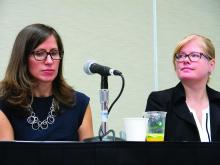Although some laboratory research shows toddlers as young as 15 months can learn new words from touch screens, they have difficulty transferring that knowledge to the three-dimensional world. For children aged 3-5 years, however, both well-designed television programming and high-quality learning apps from Public Broadcasting Service (PBS) and the Sesame Workshop have shown benefits. In addition to early literacy, math, and personal and social development skills learned from shows such as Sesame Street, preschoolers have learned literacy skills from those programs’ apps.
But those apps are unfortunately in the minority.
“Most apps parents find under the ‘educational’ category in app stores have no such evidence of efficacy, target only rote academic skills, are not based on established curricula, and use little or no input from developmental specialists and educators,” the “Media and Young Minds” policy states. “The higher-order thinking skills and executive functions essential for school success, such as task persistence, impulse control, emotion regulation, and creative, flexible thinking, are best taught through unstructured and social (not digital) play, as well as responsive parent-child interactions.”
Risks and recommendations for preschoolers
Heavy media use among preschoolers, meanwhile, carries risks of increased weight – primarily as a result of food advertising and eating while watching TV – as well as reduced sleep and cognitive, language, and social/emotional delays.
“Content is crucial,” the “Media and Young Minds” policy notes. “Experimental evidence shows that switching from violent content to educational/prosocial content results in significant improvement in behavioral symptoms, particularly for low-income boys.”
The key points of the new statement therefore include the following recommendations:
• Limit media use to 1 hour a day in children ages 2 years and older.
• Do not use screens during mealtimes and for 1 hour before bedtime.
• Start discussing family and child media use with parents early in children’s lives.
• Educate parents about early brain development and help families develop a Family Media Use Plan.
• Discourage screen use besides video-chatting in children under 18 months old.
• Encourage caregiving adults to use screen media with children aged 18-24 months, who should not use it on their own.
• Encourage parents to rely on high-quality programming products such as PBS Kids, Sesame Workshop, and Common Sense Media.
• Help parents with challenges such as setting limits, finding alternatives to screen time, and calming children without using media.
• Avoid using screens or media to calm children except during rare extenuating circumstances, such as painful medical procedures and airplane flights.
• Encourage parents to avoid fast-paced programs, apps with distracting content, any media with violent content, and any background television, which can stunt children’s early language development.
Understanding older youth’s media use
As children move into school age and adolescence, the opportunities and utilities for media use expand – and so do the risks. Children and teens can benefit from media through gaining social support, learning about healthy behaviors, and discovering new ideas and knowledge, but youth remain at risk for obesity, sleep problems, cyberbullying, compromised privacy, and exposure to inaccurate, inappropriate or unsafe content, the “Media Use in School-Aged Children and Adolescents” policy statement reports.
Despite the wide range of media types available, TV remains the most commonly used media type among school-aged children and teens and is watched an average of 2 hours a day. Still, 91% of boys have access to a video game console, and 84% report playing games online or on a mobile phone. Further, three-quarters of teens own a smartphone and 76% use at least one social media site, with more than 70% maintaining a “social media portfolio” across several platforms.
Such social media use can provide teens with helpful support networks, particularly for those with ongoing illnesses or disabilities or those needing community support as lesbian, gay, bisexual, transgender, questioning, or intersex individuals. Social media can also promote wellness and healthy behaviors such as eating well and not smoking.
Risks for school-aged children and adolescents using media
Yet social media also can open the door to cyberbullying, leading to short-term and long-term social, academic, and health problems. It carries the risk of exploitation of youth or their images, or predation from pornographers and pedophiles. Children and teens must be made aware that the “Internet is forever” and should be taught to consider privacy and confidentiality concerns in their use of social and other media.
Another concern is teens’ “sexting,” in which they share sexually explicit messages and/or partly or fully nude photos. Exposures to unhealthy behaviors, such as substance abuse, sexual behaviors, self-injury, or disordered eating are likewise among the risks of social media, as they are with television and cinema.
In fact, TV/movie content showing alcohol use, smoking, and sexual activity is linked to earlier experimentation among children and adolescents. In addition, each extra hour of television watching is associated with increase in body mass index, as is having a TV set in the bedroom. Enjoying entertainment media while doing school work is linked to poor learning and academics.
Excessive media use may lead to problematic Internet use and Internet gaming disorder as described in the DSM-5, occurring among 4%-8.5% of children and adolescents.
“Symptoms can include a preoccupation with the activity, decreased interest in offline or ‘real life’ relationships, unsuccessful attempts to decrease use and withdrawal symptoms,” the “Media Use in School-Aged Children and Adolescents” policy statement notes.


